Hydroponics - The Complete Guide for Beginners
Plants in Water: Up to 90% Less Water Consumption, 10x Higher Yields - Scientifically Based & Practically Explained
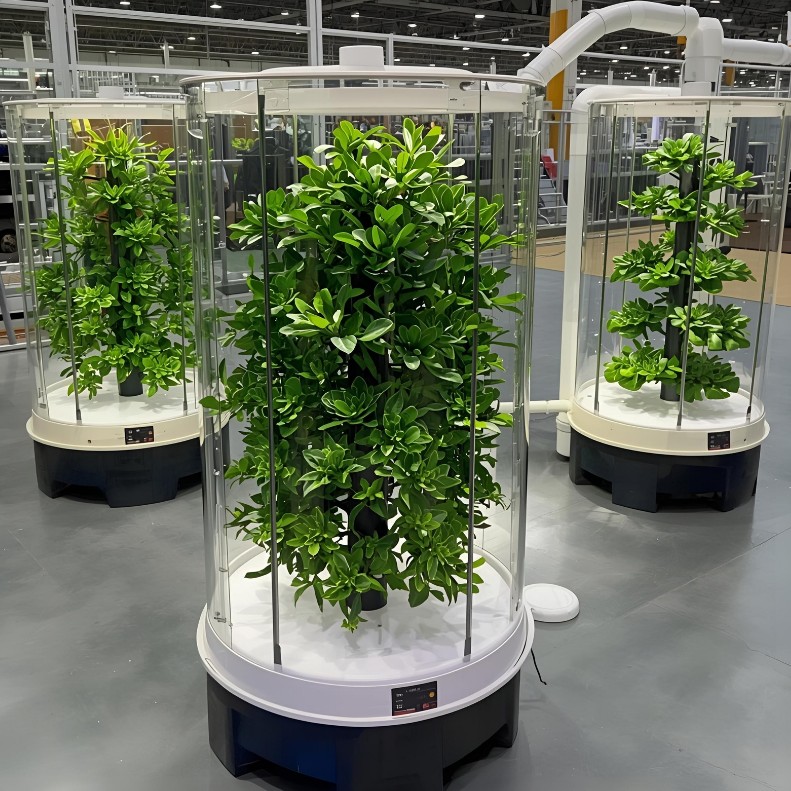
Decorative Systems / Sales Room
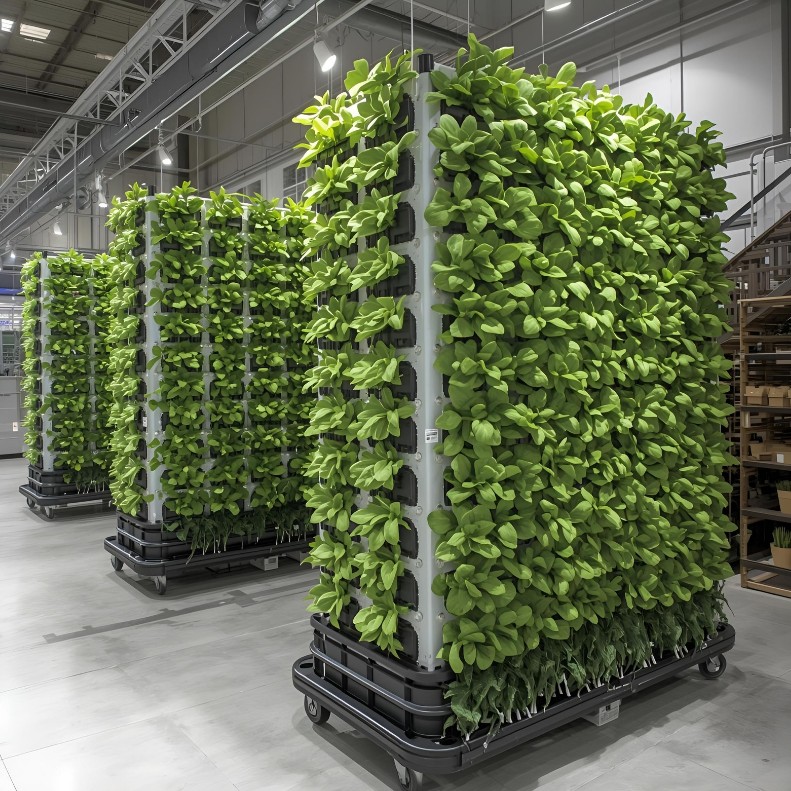
Industrial Systems
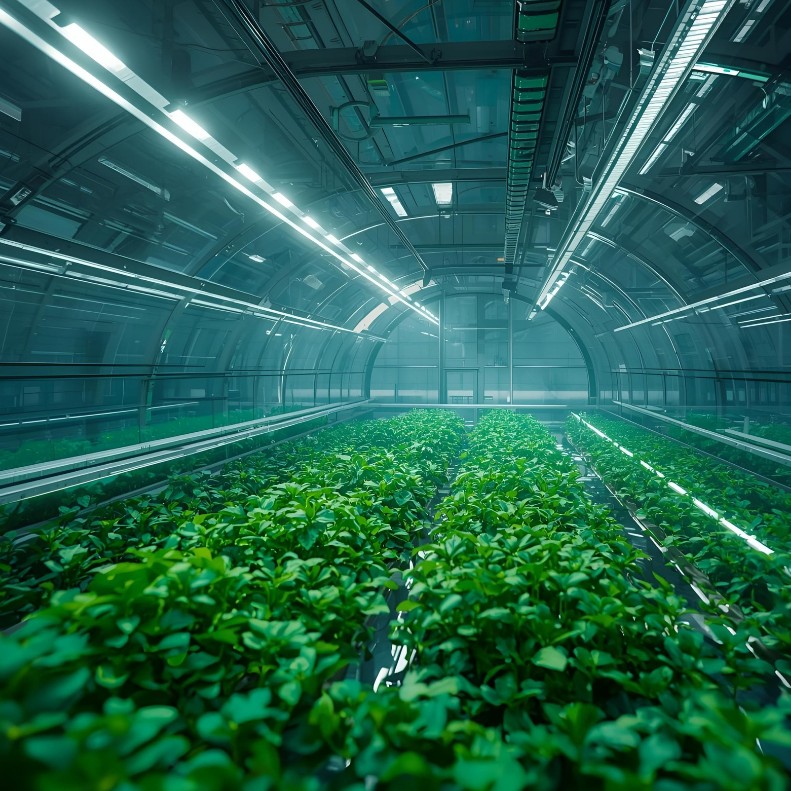
Commercial Systems
📋 Table of Contents
- 1. What is Hydroponics?
- 2. Definition & Etymology
- 3. How Does Hydroponics Work?
- 4. The 10 Most Important Advantages
- 5. Hydroponics vs. Soil Cultivation Compared
- 6. Overview of Hydroponic Systems
- 7. Hydroponics for Beginners: Step-by-Step
- 8. The 5 Best Plants for Beginners
- 9. Common Mistakes & How to Avoid Them
- 10. Cost-Benefit Analysis
- 11. FAQ - Frequently Asked Questions
- 12. Scientific Sources
What is Hydroponics?
Hydroponics is the cultivation of plants in water without soil. The roots hang directly in a nutrient solution – a mixture of water and dissolved minerals. This method allows plants to be cultivated under optimal conditions while saving up to 90% water.
Hydroponics enables the cultivation of vegetables, herbs, and fruits in the smallest of spaces – ideal for urban gardening, vertical farming, and indoor gardens. The plants are supplied with all necessary nutrients, leading to faster growth and higher yields.
A more detailed examination of the subject with sources and further literature can be found here.
Definition & Etymology
The term "Hydroponics" (English: hydroponics) is composed of the Greek words:
- Hydro (ὕδωρ) = Water
- Ponos (πόνος) = Work
Literally translated, hydroponics means "working with water" or "working in water".
Today, hydroponics is understood as any form of soilless plant cultivation where the roots hang in an aqueous nutrient solution or are bathed by it.
How Does Hydroponics Work?
The basic principle of hydroponics is surprisingly simple: Instead of laboriously drawing their nutrients from the soil, plants receive all the required minerals directly via a nutrient solution.
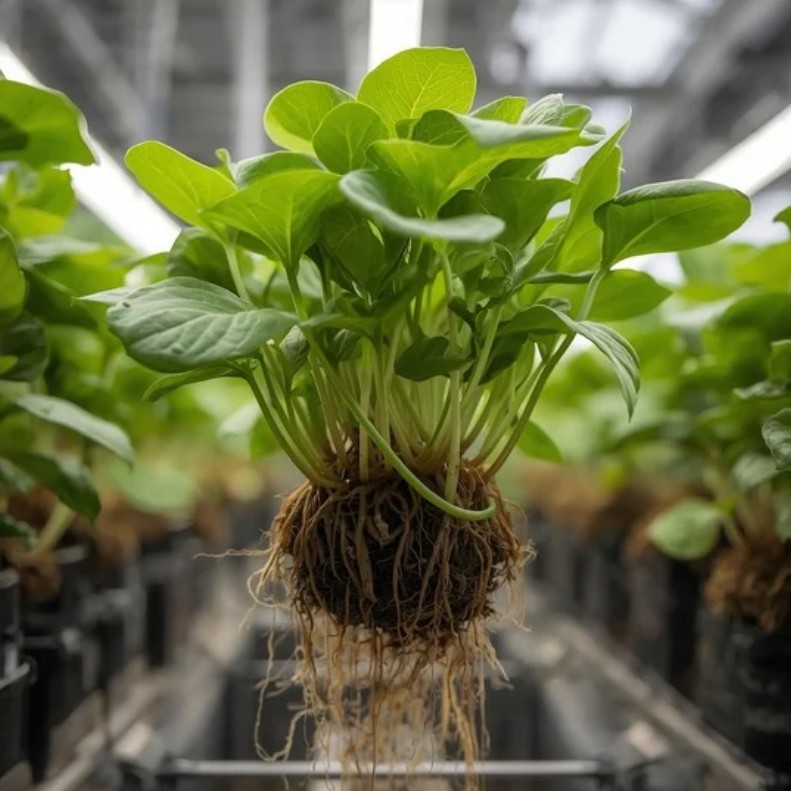
Fresher is not possible
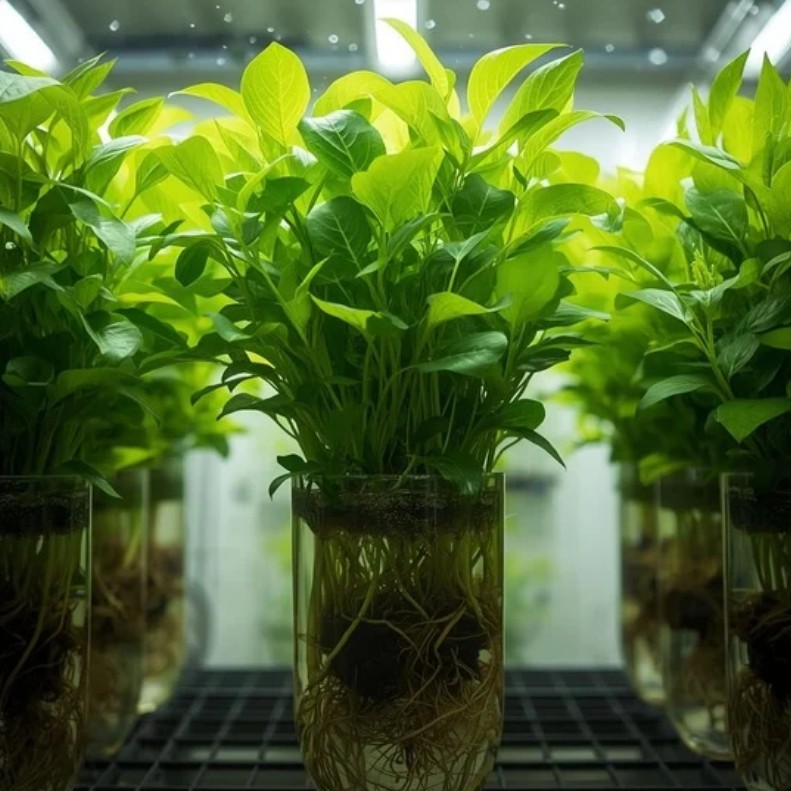
Propagation in optimal nutrient solution
The 4 Key Components:
The system forms the infrastructure of your hydroponic setup. It typically consists of:
- A water reservoir for the nutrient solution
- Plant containers or pipes
- A pump (in active systems)
- Hoses and connections
Depending on the system type, the nutrient solution can circulate, drip, or be sprayed.
The nutrient solution is the heart of hydroponics. It contains:
- Macronutrients: Nitrogen (N), Phosphorus (P), Potassium (K)
- Secondary Nutrients: Calcium, Magnesium, Sulfur
- Micronutrients: Iron, Manganese, Zinc, Copper, Boron, Molybdenum
The pH should be between 5.5 and 6.5, the electrical conductivity (EC) between 1.5 and 2.5 mS/cm (depending on the plant).
In professional systems, the pH value is allowed to fluctuate slightly, as some nutrients can be absorbed better depending on the pH level.
A short introduction to the topic of nutrients can be found here. Also pay attention to Deficiency Symptoms
The substrate fixes the plant and regulates water and oxygen supply. Popular substrates:
- Rockwool: High water retention, inexpensive
- Coconut fiber: Sustainable, good aeration
- Expanded clay: Reusable, pH neutral
- Perlite: Lightweight, good drainage
Important: The substrate itself provides no nutrients, it only serves as support!
For indoor hydroponics you need special plant lights:
- LED plant lights: Energy efficient, low heat (recommended)
- High-Pressure Sodium lamps: High light output, much heat
- Fluorescent tubes: Inexpensive for propagation
Optimal lighting duration: 14-18 hours per day for leafy greens, 12-16 hours for fruiting vegetables.
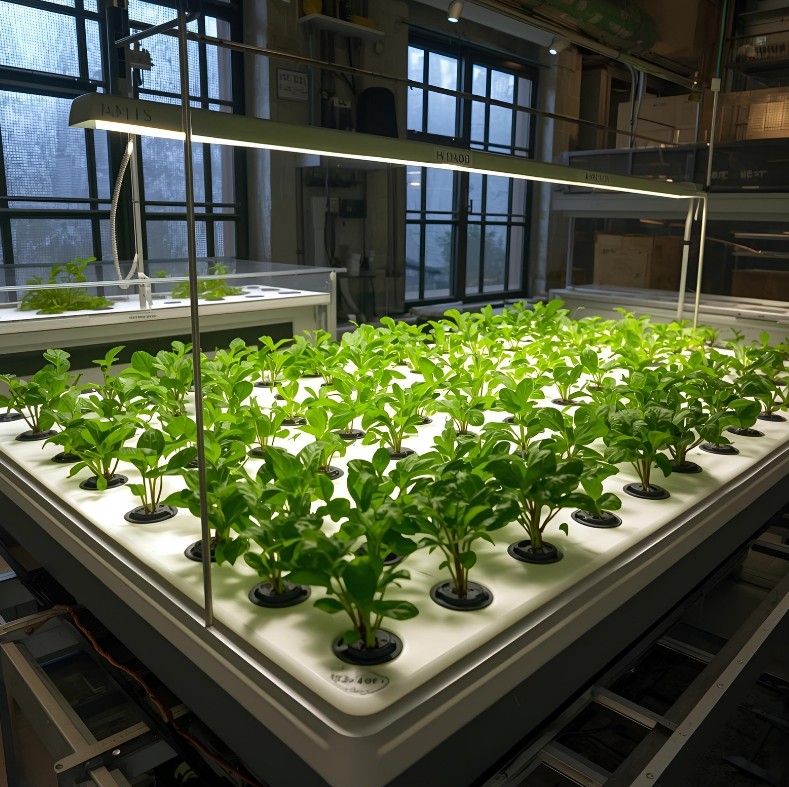
NFT Systems
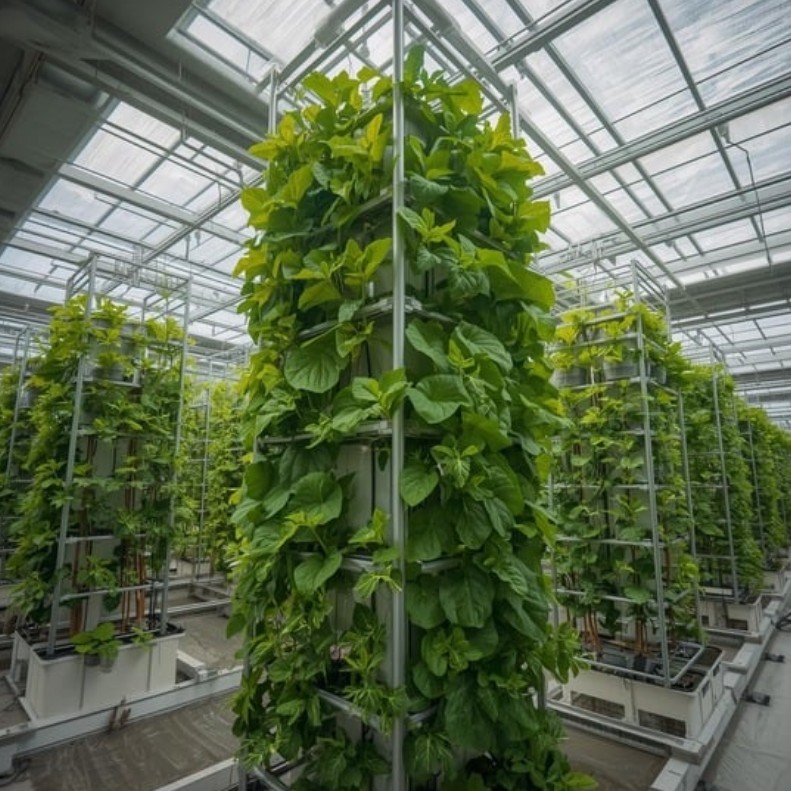
Tower Systems
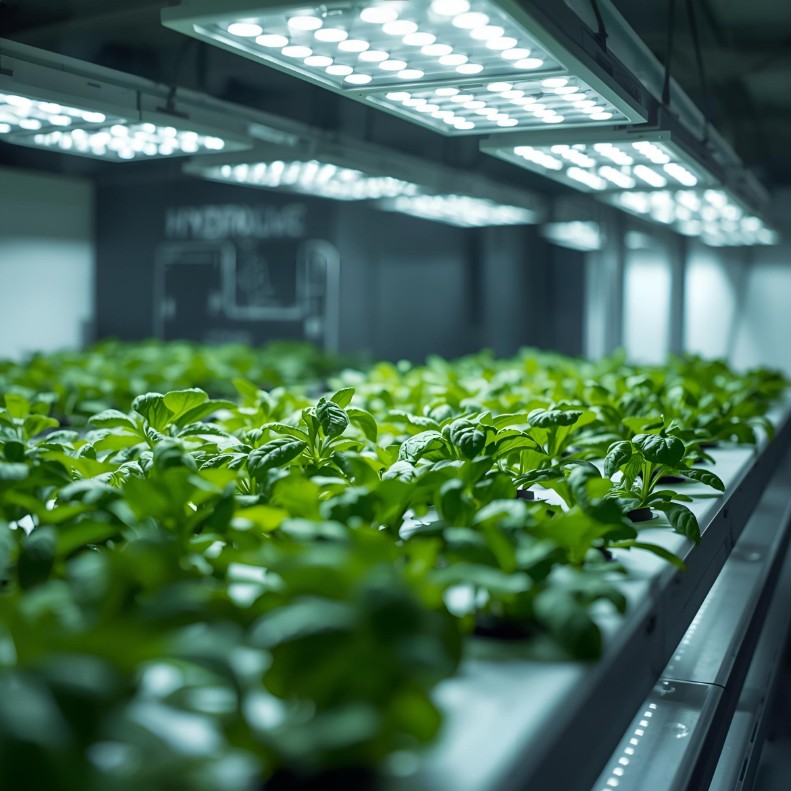
DWC Systems
The 10 Most Important Advantages of Hydroponics
1. Drastic Water Savings
Hydroponic systems use up to 90% less water than traditional agriculture. The water circulates in the system and hardly evaporates, whereas in soil-based cultivation a large portion seeps away or evaporates.
2. Higher Yields in Small Spaces
Through optimal nutrient supply and vertical cultivation, you achieve up to 10x higher yields per square meter. Plants can be placed closer together as they don't have to compete for nutrients.
3. Faster Plant Growth
Plants grow on average 25-30% faster in hydroponic systems. Direct access to nutrients and oxygen significantly accelerates growth.
4. Year-Round Harvest
Indoor hydroponics enables cultivation independent of season and weather. You can harvest fresh vegetables 365 days a year.
5. No Weed Control
Without soil, there are no weeds. This saves time and makes the use of herbicides unnecessary.
6. Fewer Pests & Diseases
Soil-borne pests and diseases are eliminated. Pesticide use can be reduced by up to 80%.
7. Precise Nutrient Control
You control exactly which nutrients your plants receive – for optimal growth and maximum quality.
8. Ideal for Urban Farming
Hydroponics requires only 20% of the space. Perfect for balconies, basements, or rooftop gardens in the city.
9. Better Quality & Taste
Optimal nutrient supply leads to more flavorful and nutrient-rich plants.
10. Sustainable & Environmentally Friendly
No soil erosion, no groundwater contamination from fertilizers, short transport routes to the consumer.
Hydroponics vs. Soil Cultivation Compared
| Criterion | Hydroponics | Soil Cultivation |
|---|---|---|
| Water Consumption | 10-20 liters/kg | 150-300 liters/kg |
| Space Requirement | 1 m² = 40+ kg lettuce/year | 1 m² = 4 kg lettuce/year |
| Growth Duration | 25-30% faster | Standard |
| Pesticides | Minimal to none | Often required |
| Weeding | Not necessary | Regularly necessary |
| Initial Investment | €200-€2000 (System) | Minimal |
| Energy Consumption | Higher (Pump, Light) | Minimal |
| Growing Location | Possible anywhere | Good soil needed |
Overview of Hydroponic Systems
There are different hydroponic systems, varying in complexity and operation. Here are the most important ones:
Passive Systems (without pump)
Operation: A wick transports the nutrient solution via capillary action from the reservoir to the roots.
Advantages:
- Simplest setup
- No electricity costs
- Ideal for beginners
Disadvantages:
- Only for small, slow-growing plants
- Limited nutrient supply
Suitable for: Herbs, small lettuces, ornamental plants
Operation: Plants sit in a container with nutrient solution. As the plant grows, the water level drops, creating an air layer for the roots.
Advantages:
- Completely passive, no electricity
- Very cost-effective
- Low maintenance
Disadvantages:
- Not for long-term crops
- Nutrient solution must be calculated precisely
Suitable for: Lettuces, herbs (single harvest)

Simple Kratky Method

Passive Wick System

Active DWC System
Active Systems (with pump)
Operation: Roots hang directly in oxygen-enriched nutrient solution. An air pump supplies the water with oxygen.
Advantages:
- Very fast growth
- Simple setup
- High yields
Disadvantages:
- Pump failure = plant death
- Temperature sensitive
Suitable for: Lettuce, tomatoes, peppers, cucumbers
Operation: A thin film of nutrient solution flows continuously over the roots in sloped pipes or channels.
Advantages:
- Very efficient
- Good oxygen supply
- Space-saving
Disadvantages:
- Sensitive to power outages
- Risk of clogging
Suitable for: Lettuces, herbs, strawberries
Operation: The plant area is periodically flooded with nutrient solution and then drained.
Advantages:
- Very versatile
- Good oxygen supply
- Suitable for many plant types
Disadvantages:
- Timer required
- Higher maintenance effort
Suitable for: Almost all plants
Operation: Nutrient solution is delivered via drippers directly to the plant roots.
Advantages:
- Very precise control
- Suitable for large plants
- Commercially proven
Disadvantages:
- Drippers can clog
- More complex setup
Suitable for: Tomatoes, peppers, large plants
Operation: Roots hang in the air and are sprayed with a fine nutrient mist.
Advantages:
- Maximum oxygen supply
- Fastest growth
- Lowest water consumption
Disadvantages:
- Complex and expensive
- Very susceptible to power outages
- High maintenance effort
Suitable for: Advanced users, commercial operations
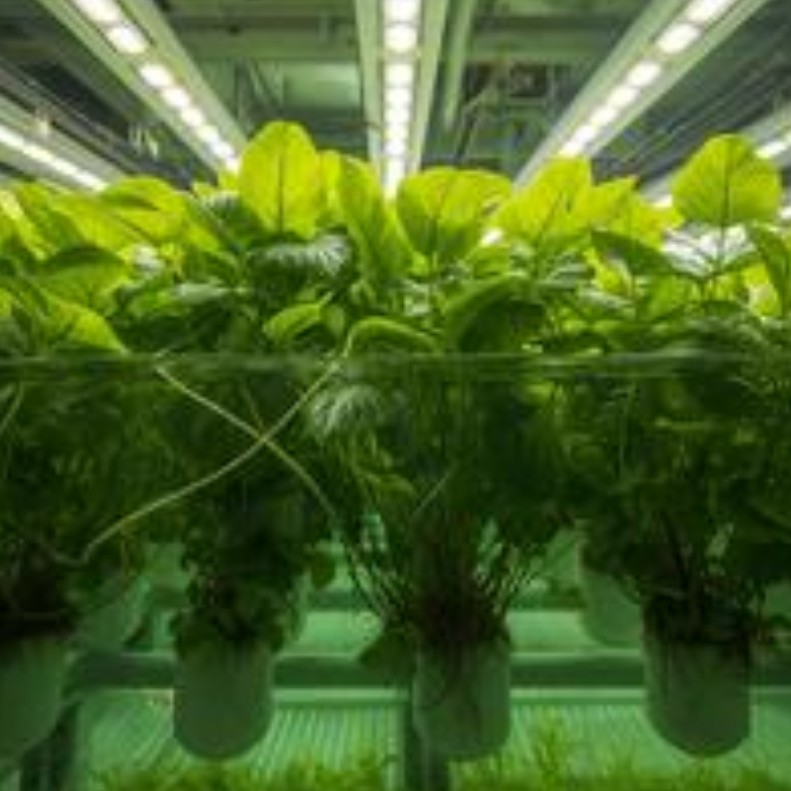
DWC System
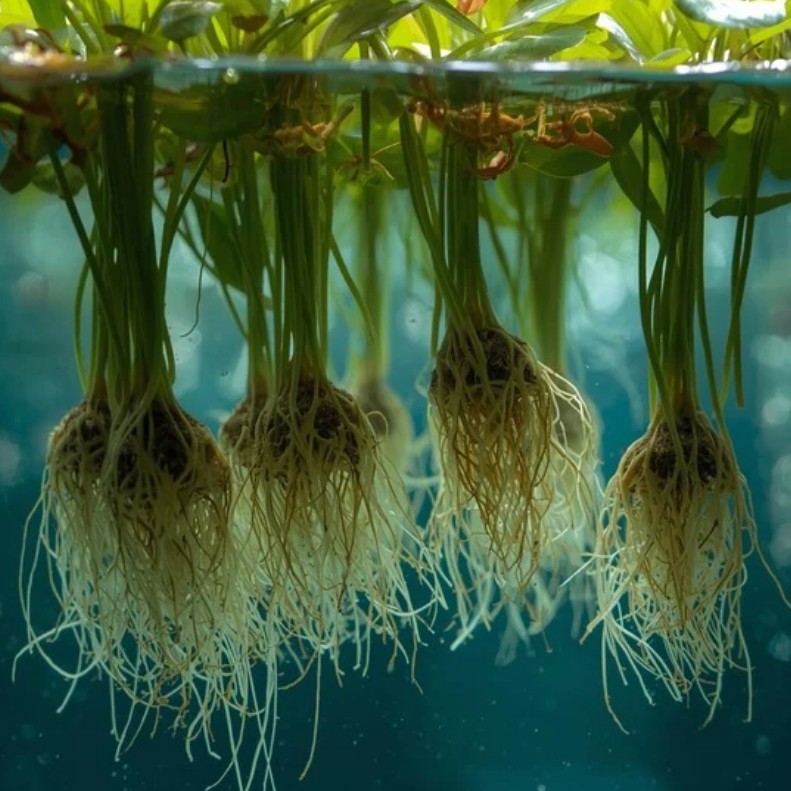
DWC System
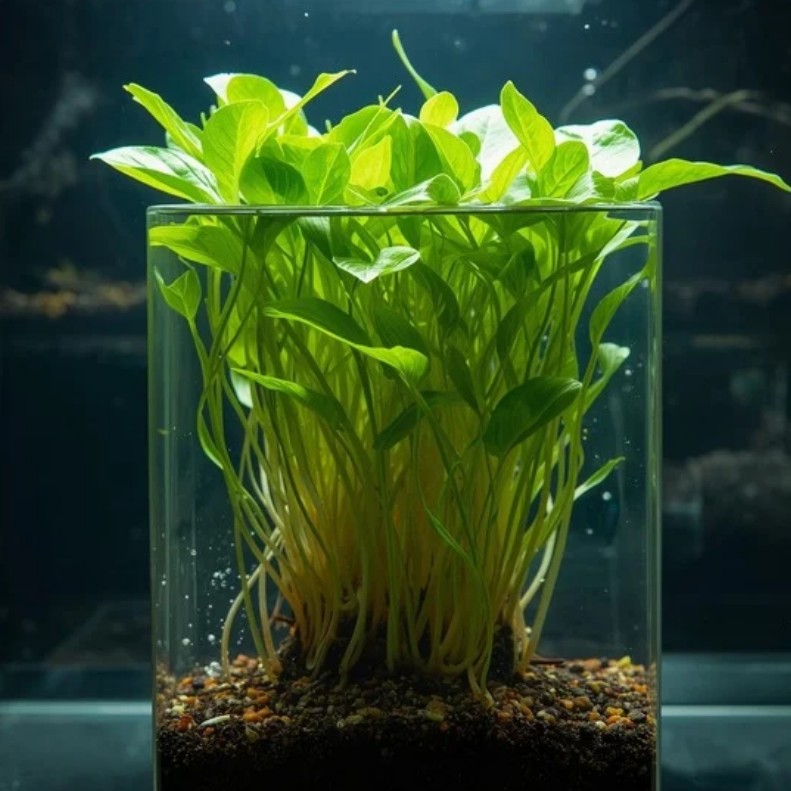
... simply decorative
Hydroponics for Beginners: Step-by-Step Guide
Want to start with hydroponics? Here is your roadmap to success:
Step 1: Choose Your First System
Recommendation for Beginners: Kratky Method or simple DWC System
- Budget: €50-€100 for a starter system
- Duration: 2-3 hours setup
- Difficulty: Easy
Step 2: Get the Materials
Basic Equipment (approx. €80):
- Container (lightproof!) - €10
- Net pots (6-8 pieces) - €15
- Substrate (expanded clay or rockwool) - €10
- Air pump with air stone - €15
- Hydroponic fertilizer - €15
- pH test kit - €10
- EC meter (optional, recommended) - €25
Step 3: Build Your System
- Drill holes in the container lid (diameter of net pots)
- Fill container with water (pH 5.5-6.5)
- Add fertilizer according to manufacturer's instructions
- Connect air pump and place air stone in water
- Fill net pots with substrate
- Place young plants
Step 4: Care & Maintenance
Daily Tasks:
- Check pump (is it running?)
- Inspect plants for pests
- Check water level
Weekly Tasks:
- Measure and adjust pH (target: 5.5-6.5)
- Measure EC value (target: 1.5-2.5 mS/cm)
- Top up water
Every 2-3 weeks:
- Perform complete water change
- Clean system
- Check roots for rot
Step 5: Harvest & Enjoy!
After 4-8 weeks (depending on plant) you can harvest. Congratulations on your first hydroponic harvest!
Was that too easy? Here is an overview of the techniques that fall under the term hydroponics.
The 5 Best Plants for Hydroponics Beginners
Why ideal for beginners: Fast growth, forgiving of mistakes, high success rate
- Harvest Time: 4-6 weeks
- pH Value: 6.0-7.0
- EC Value: 0.8-1.2 mS/cm
- Light Requirement: 12-14 hours/day
- System: NFT, DWC, Kratky
Tip: Start with head lettuce - it is the most forgiving!
Why ideal for beginners: Robust, grows like crazy, wonderful scent
- Harvest Time: 3-4 weeks (first harvest), then continuously
- pH Value: 5.5-6.5
- EC Value: 1.0-1.6 mS/cm
- Light Requirement: 14-16 hours/day
- System: DWC, NFT, Drip
Tip: Regularly pinch off the tips for bushier growth!
Why ideal for beginners: Tasty, decorative, perennial
- Harvest Time: 3-4 months after planting
- pH Value: 5.5-6.2
- EC Value: 1.0-1.4 mS/cm
- Light Requirement: 12-16 hours/day
- System: NFT, Drip, vertical
Tip: Use vertical pipes - looks spectacular!
Why ideal for beginners: High yield, outstanding taste, compact
- Harvest Time: 8-12 weeks
- pH Value: 5.5-6.5
- EC Value: 2.0-3.5 mS/cm (increase during fruit formation)
- Light Requirement: 14-18 hours/day
- System: DWC, Drip, Ebb & Flow
Tip: Don't forget supports - they get heavy with fruit!
Why ideal for beginners: Quick yield, productive, space-saving
- Harvest Time: 6-8 weeks
- pH Value: 5.5-6.0
- EC Value: 1.7-2.5 mS/cm
- Light Requirement: 14-16 hours/day
- System: DWC, Drip, NFT
Tip: Choose snack cucumbers - more compact growth!
9 Common Beginner Mistakes & How to Avoid Them
Problem: Plants cannot absorb nutrients → deficiency symptoms despite fertilization
Solution: Measure pH weekly and adjust to 5.5-6.5 with pH-Up/pH-Down
Problem: Algae growth in water → clogged pumps, oxygen deficiency
Solution: Use only lightproof, black containers. If necessary, wrap with aluminum foil
Problem: Over 25°C → oxygen deficiency, root rot
Solution: Choose a cool location, if necessary use a cooling pack in the water, avoid in summer
Problem: Nutrient burn → brown leaf edges, stunted growth
Solution: Start with 50% of manufacturer's recommendation, measure EC value, increase slowly
Problem: Salt deposits, pH shift, nutrient imbalance
Solution: Complete water change every 2-3 weeks, mark it in the calendar!
Problem: Plants compete for light, poor air circulation → mold
Solution: Maintain distances: Lettuce 15cm, Tomatoes 30cm, Basil 20cm
Problem: Leggy growth (long, thin shoots) or stunted growth
Solution: Use full-spectrum LED, 30-50 Watts per m² for leafy greens, 50-80 Watts for fruiting vegetables
Problem: High humidity → mold, weak growth
Solution: Install a fan for air circulation, ventilate regularly
Problem: Constant checking, repotting, system changes → stress for plants
Solution: Be patient! Let your system work. Less is often more.
Cost-Benefit Analysis: Is Hydroponics Worth It?
Let's do the math - is hydroponics economically viable?
One-Time Investment (Beginner System)
| Item | Cost |
|---|---|
| Container & Net Pots | €25 |
| Air Pump & Accessories | €15 |
| Substrate (Expanded Clay) | €10 |
| Measuring Devices (pH, EC) | €35 |
| Plant Light (LED, 30W) | €40 |
| Total | €125 |
Running Costs (per month)
| Item | Cost/Month |
|---|---|
| Fertilizer | €3 |
| Electricity (Pump + Light, €0.30/kWh) | €8 |
| Water | €1 |
| Consumables (pH regulators) | €2 |
| Total | €14 |
Yield & Amortization
Example: 6 Lettuce Plants in DWC System
- Harvest every 6 weeks = approx. 8-9 harvests per year
- 6 lettuces × 9 harvests = 54 lettuces per year
- Supermarket price organic lettuce: approx. €2.50
- Savings: 54 × €2.50 = €135 per year
- Year 1: €135 savings - €125 investment - €168 running costs = -€158
- Year 2: €135 savings - €168 running costs = -€33
- From Year 3: Annual savings without major new investments
But: Freshness, pesticide-free, no transport routes, hobby value priceless!
Increase Profitability
- More Plants: 20 lettuce heads → €450 savings/year
- High-Value Plants: Basil (pot €3), Tomatoes (Organic €8/kg)
- Outdoor in Summer: No electricity costs for light
- Kratky instead of DWC: No electricity costs
Conclusion: From 15-20 plants or with high-value crops (tomatoes, basil) hydroponics pays off already in the first year!
Here you can use our calculator to get an idea of the yield and amortization.
FAQ - Frequently Asked Questions
No, on the contrary! With optimal nutrient supply, hydroponic plants often taste more intense. Studies show that tomatoes and basil from hydroponics have higher levels of essential oils and aromas. The taste depends primarily on the variety, nutrient composition, and light quality - not on the medium.
Legally no - organic certifications require soil cultivation. This is a political decision by the EU based on successful lobbying by the agricultural industry. Purely factually, the environmental balance of hydroponics is far superior to field cultivation in almost all aspects.
The advantages are obvious:
- 90% less water
- No pesticides needed
- No soil erosion
- Local production = short transport routes
With organic fertilizers you can also practice "bio-hydroponics".
A critical article on this can be found here - with some uncomfortable truths - one must be that honest!
For Beginners: Mineral 2- or 3-component fertilizers
- General Hydroponics Flora Series
- Advanced Nutrients pH Perfect
- Canna Aqua
For Advanced: Organic fertilizers from compost tea, worm humus extract
Important: NO normal liquid fertilizer! It contains too few micronutrients.
Pros mix their own fertilizer: this achieves a tailored supply and it is cheaper
If the plants show deficiency symptoms the cause can be quickly found here.
Rule of Thumb: Complete water change every 2-3 weeks
More often with:
- Large, fast-growing plants
- Small reservoirs
- High temperatures
Less often with: Kratky Method (no change until harvest)
Yes, absolutely! Outdoor hydroponics is ideal from April to October:
Advantages:
- Free sunlight
- No electricity costs for lighting
- Natural pollination (for fruiting vegetables)
Note:
- Protect reservoir from direct sun (overheating!)
- Bring indoors in case of frost
- Rainwater can shift pH
No! Almost any plant can grow hydroponically. Normal seeds/young plants work perfectly.
Tip for young plants from the garden center:
- Carefully remove plant from pot
- Gently rinse roots under lukewarm water to remove soil
- Place in net pot with substrate
- First week lower nutrient concentration (EC 0.8)
DWC, Aeroponics, Fogponics: Critical! Without oxygen supply, roots die after 4-8 hours
NFT, vertical systems (Tower): Very critical! The plant, or rather the root, dries out within a few hours
Prevention:
- Battery-powered backup water pump (aquarium)
- Battery-powered backup air pump (aquarium)
- Larger water reservoir = more buffer
- NFT/Ebb & Flow: More tolerant (12-24h no problem)
Kratky/Wick: No problem - passive systems!
Common Deficiencies & Symptoms:
- Nitrogen (N): Yellow lower leaves, slow growth
- Phosphorus (P): Dark, purple leaves, weak root growth
- Potassium (K): Brown leaf edges, yellow spots
- Calcium (Ca): Deformed new leaves, blossom end rot in tomatoes
- Magnesium (Mg): Yellow leaves with green veins
- Iron (Fe): Yellow young leaves, green veins
A detailed analysis can be carried out here.
Tip: Usually it's the pH value! First check pH (5.5 - 6.5) and EC value (1.5 - 2.5) then possibly increase fertilizer.
Ready for Your Hydroponics Adventure?
Start now with your first system and experience the future of gardening!
To the Step-by-Step Guide📚 Scientific Sources & Further Reading
- Gericke, W. F. (1940). The Complete Guide to Soilless Gardening. American Midland Naturalist, 24(3), 766. [Source]
- Barbosa, G. L., et al. (2015). Comparison of Land, Water, and Energy Requirements of Lettuce Grown Using Hydroponic vs. Conventional Agricultural Methods. International Journal of Environmental Research and Public Health, 12(6), 6879-6891. [Source]
- Resh, H. M. (2012). Hydroponic Food Production: A Definitive Guidebook for the Advanced Home Gardener and the Commercial Hydroponic Grower. CRC Press.
- United Nations (2018). The United Nations World Water Development Report 2018: Nature-Based Solutions for Water. UNESCO. [Source]
- Jensen, M. H. (1997). Hydroponics. HortScience, 32(6), 1018-1021.
- Savvas, D. (2003). Hydroponics: A Modern Technology Supporting the Application of Integrated Crop Management in Greenhouse. Food, Agriculture & Environment, 1(1), 80-86.
- Despommier, D. (2013). Farming Up the City: The Rise of Urban Vertical Farms. Trends in Biotechnology, 31(7), 388-389.
Further Information:
- International Society for Horticultural Science - www.ishs.org
- Hydroponic Society of America - www.hydroponicsociety.org
Kontext:


💬 Your Experiences with Hydroponics
Do you have questions or want to share your experiences? Write us a comment! The community is happy to help.